USG - Sustainability is here to stay - PODCAST TRANSCRIPT
January 18, 2024 at 12:00 p.m.Editor's note: The following is the transcript of a live interview with Stacy Simpson of USG. You can Read the interview below, Listen to the podcast or Watch the video.
Intro: Welcome to Roofing Road Trips with Heidi. Explore the roofing industry through the eyes of a long-term professional within the trade. Listen for insights, interviews and exciting news in the roofing industry today.
Heidi J. Ellsworth: Hello, and welcome to another Roofing Road Trips from RoofersCoffeeShop. My name is Heidi Ellsworth, and we are talking today about one of my favorite topics, and that's sustainability. For 30 years now, I've been in the roofing industry and we've been talking about solar, sustainability, green roofs. But things are really happening now, and today. And so we asked our friends at USG to be a part of this discussion, and I am so excited to have this time to visit with Stacy Simpson with USG about sustainability. Welcome, Stacy.
Stacy Simpson: Hi, Heidi. Thank you for having me.
Heidi J. Ellsworth: I love this topic; I could talk about it all day long. Before we dive in, why don't you go ahead and introduce yourself. Tell us a little bit of what you do at USG, and about USG itself.
Stacy Simpson: Absolutely. Hello, my name is Stacy Simpson, and I am the sustainability manager at USG. I've been with USG for 10 years now, all working in the sustainability department. I have a BS in biology and chemistry for Purdue University, and a MS in environmental engineering from Illinois Tech.
Heidi J. Ellsworth: Wow.
Stacy Simpson: I've always known that I wanted to work within the building materials area, I see there's a lot of room for improvement in this industry since the built environment can have such an impact on the occupants and the outdoor environment. I developed the USG 2030 Sustainability Goals, and I worked to implement and track the goals. And I help with integrating sustainability within the culture at USG, and I am a true promoter of sustainability within my daily life.
Heidi J. Ellsworth: Stacy, I'm so impressed, across the board. First of all, what a great job to be able to do that every day and live that, and working with a great company. Before we talk about USG, I'd really love to hear what you're seeing overall in the built environment, in roofing, but also building envelope, what you're seeing overall around sustainability.
Stacy Simpson: Great change. Absolutely. More people trying to do and make a bigger difference. It's actually been a very exciting time for sustainability.
Heidi J. Ellsworth: It really is. I will say, my son graduated with environmental, and he's our chief of staff, and he has brought a lot of that to RoofersCoffeeShop too. We need these advocates, these ambassadors who are really talking about it. Okay. As you are seeing, we're talking about the overall. And we see all the EPDs, we see the solar, we see the green roofs, but what are you specifically seeing in roofing that's really changing around sustainability and taking that next step?
Stacy Simpson: Well, with roofing and with the products that we make, it adds more resilience. It's adding an additional layer to the elements, which unfortunately have been a little bit more harsh. For roofing, and specifically for USG, we are promoters of protecting everything within the indoor environment, of course. I think it's more about designing for the elements and designing for the long term. Yeah.
Heidi J. Ellsworth: Well, and I love what you talk about with resiliency, because a lot of times people aren't always connecting that to sustainability.
Stacy Simpson: Absolutely.
Heidi J. Ellsworth: But the less we have to go into landfills, the better. Right?
Stacy Simpson: Absolutely. The less repairs, right? The less repairs you do, the more you avoid those carbon emissions associated with the repairs.
Heidi J. Ellsworth: And that is key. And sometimes I think that has really been lost in the conversation, and that is really starting to take a forefront right now. Let's talk about the commitment to sustainability with USG. And when you talked about developing the 2030 plan, I'd really love to hear about that.
Stacy Simpson: Yeah. We're a company that's been innovating for 100 years, and sustainability is no different. We developed goals in four areas of sustainability, transforming our footprint. We are reducing our carbon emissions throughout the company. We are working towards a reduction in our direct and our indirect emissions, from the fuel we burn to the supply chain. Basically every department within USG. We have a 30% reduction in our scope one, which is the natural gas that we burn. Our Scope two emissions, which is the electricity that we purchase. And a 15% in our Scope three emissions, which is mostly our raw materials for us. And as mentioned, we did get our targets verified by SBTI, which is a third party platform that verifies the carbon emission goals that are in line with climate science. We will be publicly reporting our progress starting in 2024.
And then our second goal is enhancing customer wellbeing. We are eliminating all the LBC red list chemicals, or the chemicals that are deemed as the worst of the worst in the building materials industry. Publishing transparency documents for all products, which includes both environmental and the health transparency documents, as well as the CDPHO 1350, or the BOC emission certificates. We are also dedicating a lot of research and development to sustainable products. Delivering a circular economy, we have committed to zero manufacturing waste to landfill.
Heidi J. Ellsworth: Wow.
Stacy Simpson: And a 20% reduction in drinking water intensity. And we aim to be the leader in wallboard and ceiling take-back programs. And our last one is putting people first. And we want our workforce to be happy, we want to foster and engage in diverse workforce that everybody likes coming to work and enjoys working for USG.
Heidi J. Ellsworth: Those are amazing goals. I want to talk just a little bit, and there's so many things there that I think we should talk about. One of them is the take-back program. This is a big topic with roofing contractors all the time. How do we recycle? What do we do? There's more mandates coming out all the time. How's that program going to work?
Stacy Simpson: We just came out with the wallboard take-back program. We try to make it as easy as possible. It's like a one-to-one basis, you contact us and we just work it out. To say it like that, we work it out.
Heidi J. Ellsworth: That's great.
Stacy Simpson: We are developing roofing take-back program, especially for the Securock Gypsum-Fiber roof board. It is in development. And at some time I am hopeful that all eligible products will be able to be taken back.
Heidi J. Ellsworth: Yeah. We're hearing about it out of California right now. There are actually huge fees that if you are not recycling and if you're not sorting correctly. And so the other thing, part that caught my ear when you were talking about your goals, was that you're going to be manufacturing with zero landfill, zero waste going to landfill. How's that work?
Stacy Simpson: It's very difficult to do. I will say that it's a work in progress, and we are still working out all the kinks. But mainly it's to improve our efficiency to the point where we don't have anything to take back. Or-
Heidi J. Ellsworth: Awesome.
Stacy Simpson: ... work that waste back into our line.
Heidi J. Ellsworth: Yeah, we're hearing a lot about that. How can you take that waste and recycle it or repurpose it back into the line? I guess that's a little bit of a circular economy.
Stacy Simpson: It is.
Heidi J. Ellsworth: Yeah. And when you talk about that, you're talking about in the manufacturing, but then once it gets on the roof or on the walls. And how is that going across the board? Those are big goals for 2030. And I love the fact, I love your transparency of we're working on it. But you've made the goals, I think that's so important.
Stacy Simpson: If it is easy, it's not really worth doing, right?
Heidi J. Ellsworth: Yeah.
Stacy Simpson: It's got to be a strong commitment and you got to put work towards it.
Heidi J. Ellsworth: When I look at this, first of all, very impressive. And I'm just curious, the initiation from the USG leadership executive team to, first of all, hire you. To second of all say, we're going to make these goals for 2030. Talk to me a little bit about that leadership and how that really has their commitment, how it came about to make this commitment to sustainability.
Stacy Simpson: Our leadership has been absolutely committed. We actually had, when we first proposed the goals, there were a little bit less than what we have now. And they actually told us to go back. Go back and start over. They wanted something more stringent, which was awesome. And then Chris Griffin, our CEO, he has solar panels on his house. Which [inaudible 00:10:09]-
Heidi J. Ellsworth: Love it.
Stacy Simpson: ... as well. They are so supportive in getting sustainability to every quarter of USG.
Heidi J. Ellsworth: That is so great. One of the other things you talked about when we were talking about the goals, you talked about the red list chemicals. I find that very interesting. Because you know what, people don't talk about that too much, at least not in roofing. Talk to us a little bit about what that is. What are those red list chemicals, and how is that going to work?
Stacy Simpson: Some of these chemicals have just been the norm within manufacturing.
Heidi J. Ellsworth: Because I've been doing this probably a little bit longer than you, Stacy, and I worked for some major manufacturers also. And there's always this, well, it works, it performs, we're going to keep it. It doesn't matter. Let's stop everybody from making those changes. Whereas what I'm hearing from you, you're saying there's new formulations, there's new technology, there's new ways of doing things and we don't have to use these. To me, that is about as progressive and caring about the environment that you can get, because it takes time and energy to do that. When you think about it, I'm thinking about as you're putting this together, you're bringing all the scientists, all the great innovation of USG, you're bringing it all to the forefront.
Stacy Simpson: Absolutely. Without having the effects on the product or the effects of why the chemical is used in the first place. I will tell you there's a dispersant that's used that, of course, decreases the amount of water, which of course saves carbon. Once we remove that, we have to also think how to not increase the carbon as well. It's a balance game.
Heidi J. Ellsworth: It is. That's really interesting. And we've actually had that conversation before with folks on our podcasts and webinars, is that we're talking about you do this and then this affects that, and you do this and it affects that. And so I like the fact, the balanced view of how do we bring all this together at the end to meet the goals to save the planet. I know that's a big thing, but it is the most important. Okay. Let's talk about Gypsum-Fiber roof board. Where is that fitting in all of your goals and initiatives?
Stacy Simpson: Well, the crazy thing is that we just released the CDPHO 1350 certification for Securock Gypsum-Fiber roof board.
Heidi J. Ellsworth: Yes.
Stacy Simpson: It's a low BOC emitting product. We just released at HPD, which actually tells the whole formulation of the product. Then we have had a EPD, or the environmental product declaration, which tells us about the environmental attributes. As well as a declare label for the product, which has the LBC red list free status.
Heidi J. Ellsworth: Nice. And this is something roofing contractors can really use. When they can pull that EPD for Gypsum-Fiber roof board and go to building owners and say, "Look how sustainable this is, look what it's doing, how much healthier it's going to be for your building and for your tenants." I think that is really important. What's some of your wisdom to some of the contractors out there as they're talking about these products? And specifically talking about the fiber roof board that we're just talking about, how did they take your message and carry it on?
Stacy Simpson: Well, I think first off, it's for a purpose. Using the roof board protects all the indoor environment, where the occupants are. Number one for that extra protection, you're protecting the insulation, the longevity of the building and all that really is involved within sustainability.
Heidi J. Ellsworth: That is great. And so, why is it important that contractors even understand this, and for their own business models? Because it's one thing, this is great work on the manufacturing level, but how do we keep going down within the roofing industry and get it into the roofing contractor companies?
Stacy Simpson: A big important part with contractors using it is when their building owners want to actually go for the green building certificate, like LEED, having that experience already makes them a lot more marketable. That's something that they actually have in their back pocket. It's not just doing the right thing, but it's also for themselves it would be great. Then additionally, we are seeing a lot more owners demanding it. They're demanding greener buildings, they're demanding greener job sites. It's just their preference. Of course you have to do what your customer's asking you to do, right?
Heidi J. Ellsworth: Right. Or you're going to be left behind.
Stacy Simpson: Absolutely.
Heidi J. Ellsworth: It really feels that way to me. Like we started, Stacy's been in this conversation for about 30 years, and it never really... We have all these LEED buildings, and it's great we have all the solar, everything, the green roofs. But it really feels like now it is going to that next level and that next step. And if roofing companies are not embracing this, they're going to really be left behind and lose business.
Stacy Simpson: Absolutely. Even if there is some regulations behind it as well, we've seen that in Europe right now. So at some time it could come to us.
Heidi J. Ellsworth: Yeah, I really see that. We're already seeing it in California. We're seeing a little bit in Florida. And I think it is going to be a change. The roofing contractors who are out there listening to this right now, what are some of your tips for them embracing the sustainability? What can they be doing in their business right now?
Stacy Simpson: Using the documents that we have out, use the HPDs, use the declare labels, use the EPDs to make the decision. That's why they're out there. We give you the tools to actually make that decision. Use the whole building LCA. This is starting to really take on momentum. Project teams are actually planning with the whole building LCA. If you can, or if we have it available, utilize the take-back programs.
Heidi J. Ellsworth: Yes. Okay. I'm going to go back just for a few of those, and maybe I didn't catch it earlier. But LCA, just for our listeners, what does that stand for?
Stacy Simpson: That's the lifecycle assessment. That's all our inputs, all of our energy. It's a snapshot of all the environmental attributes that are manufacturing a product cause.
Heidi J. Ellsworth: Yeah. Okay. Okay. That makes total sense. I want to make sure, because thinking if I'm questioning that, I bet somebody else out there is too. That makes sense, is to really look at that whole life cycle and understand. I think the cradle to grave is one of the terms that they talk about a lot too, and recycling and products and sustainability. So really looking at that. And I think one of the things too, that I want your opinion on, is I think it's really important that roofing companies and roofing contractors, owners, sales, that they're having this conversation with their manufacturers. Asking these questions. Where do you stand on all of this? Don't you think so?
Stacy Simpson: Absolutely. Absolutely. They're pushing the market, and they're using it. Nobody could do this alone. It's going to have to be manufacturers, contractors, architects. It's going to have to be everybody to make a change.
Heidi J. Ellsworth: It really is, all working together. Well, I have to say, I am incredibly impressed. How are you feeling about getting to those 2030 goals?
Stacy Simpson: It's a lot of hard work, I'm not going to lie. It is, and we're committed to doing it. As long as we have everybody within the organization have sustainability in mind when making decisions, I feel very good about it.
Heidi J. Ellsworth: Yeah, I do too. And when you have leadership like you, I don't see why it wouldn't be a huge success. And I have to say, and some people may be seeing this video, but most of you're listening. I just have to tell you, Stacey is our future. She is the next generation. And you are really important to the leadership for roofing and building overall that we have this kind of leadership coming out of Illinois Tech, and also bringing it to USG. thank you for all you're doing.
Stacy Simpson: Well, thank you. Thank you for your love of sustainability too.
Heidi J. Ellsworth: I know, I started way back there, way back there. A little Gen Xer here on my part. But thank you so much. And I just want to encourage everyone to check out the USG directory on RoofersCoffeeShop, because we have articles on this. We are writing about it, we're talking about it. And it's something to track. And also, I just can't say enough, ask all of your manufacturers if they're also doing this. How can you put full systems together that are going to really make a difference for the building owners and for the environment? Stacey, once again, thank you so much for your time today. I really love this.
Stacy Simpson: Thank you for having me.
Heidi J. Ellsworth: Thank you. And thank you all for listening. This is the information that can help you grow into 2030. You need to know about it and start incorporating it in your business. If you want more information, visit the USG directory on RoofersCoffeeShop. And follow the articles that are coming out, there is a lot of great information that's going to help you meet your own goals for 2030 and beyond. Also, be sure to check out all of our podcasts under the RLW navigation under Roofing Road Trips, and be sure to subscribe and set those notifications on your favorite podcast channel so you don't miss a single episode. We'll be seeing you next time on Roofing Road Trips.
Outro: Make sure to subscribe to our channel and leave a review. Thanks for listening. This has been Roofing Road Trips with Heidi, from the RoofersCoffeeShop.com.

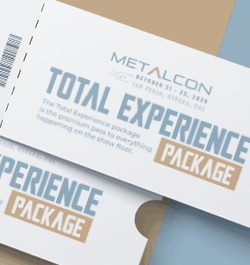



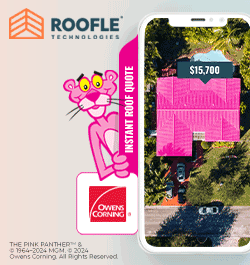







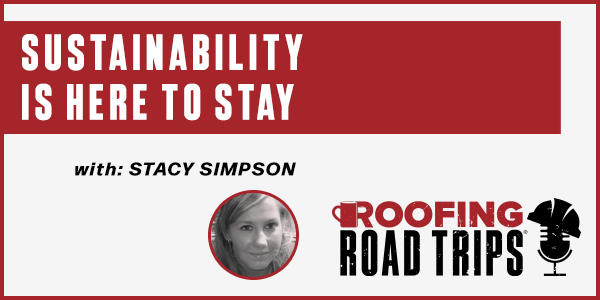

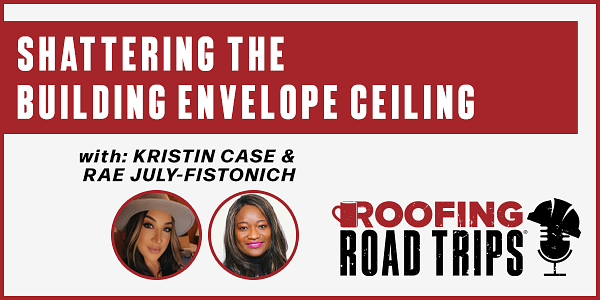
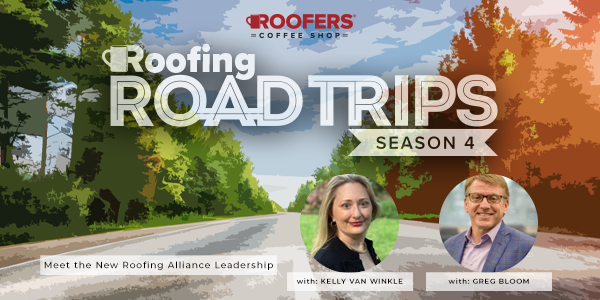







Comments
Leave a Reply
Have an account? Login to leave a comment!
Sign In